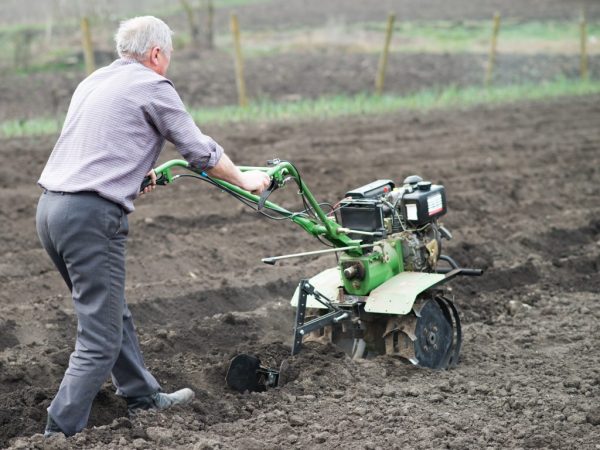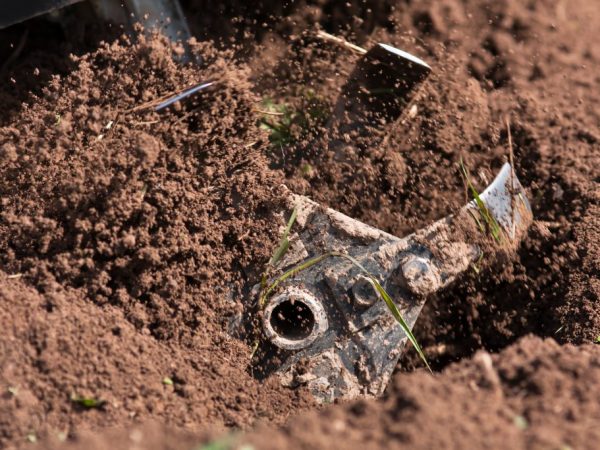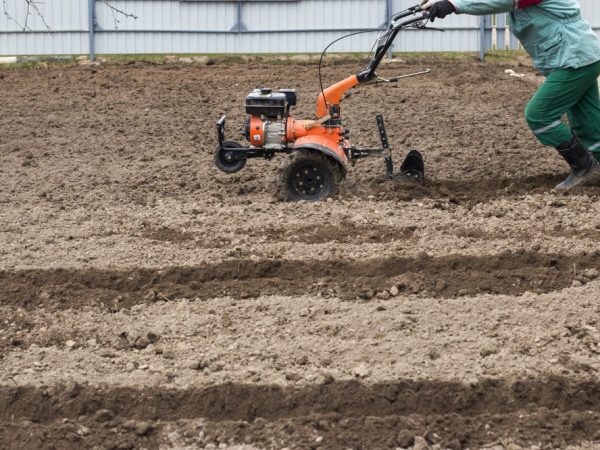Motoblock when planting potatoes
Every gardener is engaged in growing potatoes. The vegetable is one of the staples of the culinary scene, which makes it highly demanded. Planting potatoes with a walk-behind tractor is effective in medium-sized areas. The device speeds up the planting process, and is also used for the entire growing and harvesting period.

Motoblock when planting potatoes
Using a walk-behind tractor
To plant potatoes using a walk-behind tractor, the following brands of devices are used:
- Oka;
- Bison;
- Sich;
- Caiman;
- Tarpan;
- Hopper;
- Centaur;
- Plowman;
- Belarusian 09n;
- Mole;
- Neva;
- Cascade;
- Ugra;
- Agro;
- Patriot;
- Farmer;
- Salute.
Advantages of motoblocks:
- Versatility (the simplest and most universal are the Oka and Neva). The units are used for all types of work in the garden. They are suitable for soil cultivation, planting and harvesting.
- Compactness (Oka). Motoblocks do not weigh as much as heavy equipment and do not take up much space.
- Profitability. The engine of the unit does not require a lot of fuel. The unit consumes 100 ml in 10 minutes.
- Accurate work with the soil during processing (Oka). The walk-behind tractor does not create strong pressure on the ground, like tractors such as MTZ-50 and MTZ-80.
- Ease of use (Neva). The unit is easy to operate and simple to maintain.
Seed preparation
The first step is to cut the seed so that it is the same size. You only need to cut large tubers, but it is better to use medium-sized potatoes. It gives a better yield compared to a small one.
The seed must be germinated. To do this, the potatoes are placed in a warm and bright place for a month. When sorting tubers, discard those with dark spots. This is a sign of a viral disease. Before planting, potatoes are treated with a chemical solution against diseases.
Soil preparation

The soil needs to be plowed
Before planting potatoes with a walk-behind tractor, warm up the soil to 8-10 ℃. For a better harvest, mineral and organic fertilizers are added to the soil.
The soil must be plowed to a depth of 13-16 cm. For this, a cutter is installed on the cultivator. Planting potatoes with a walk-behind tractor will be better if you remove the wings on the unit and adjust the stroke. The next step is booking. The purpose of the procedure is to saturate the soil with moisture and oxygen.
All operations are done by one unit, on which the following modifiers are hung:
- cutter;
- plow;
- hiller;
- planter;
- coupling;
- lugs;
- wheel extensions;
Disembarkation rules
Regardless of the method of planting potatoes using a walk-behind tractor, you should follow these tips:
- fertilize the soil before planting;
- make even furrows, which will facilitate maintenance;
- row spacing in the region of 50-70 cm;
- the distance between the bushes is 20-35 cm;
- planting depth 10-13 cm.
The distance should be the same for all bushes. The width is uniform along the entire length of the row.To do this, pull the approximate ropes along the site.
Using the hiller
Planting potatoes with a walk-behind tractor with a hiller is used in small areas. The landing itself takes place manually, the walk-behind tractor cuts furrows. When using a hiller, lugs are installed on the walk-behind tractor.
After disembarkation, the device is changed to standard rubber wheels. This prevents damage to the potatoes when buried.
For convenience, the hillers are additionally equipped with mounted planters. This allows you to reduce the cost of human labor.
The unit consists of the following set of accessories:
- Conveyor. The mechanism works on the principle of a conveyor and feeds potatoes.
- The furrower. Cuts a furrow.
- Distributor. Regulates the rate at which the potatoes are fed.
- Disk. Used for hilling. Fills furrows with soil after planting.
Plowing

The plow will speed up the potato planting process
The advantage of planting potatoes using a walk-behind tractor with a plow is the ease of performing the operation. The disadvantage of this method is the need to manually lay the potatoes in a rut. The plow acts as a working body. They are planted both single-row and double-row double.
The implementation technology consists in introducing the plow into the ground when the walk-behind tractor is moving. The working body digs the ground to a depth of 10-12 cm.
It is better for two people to plant potatoes with a plow. The first works as an aggregate and monitors the width of the row spacing, and the second places the potatoes in the ground. Plant faster with a two-row plow.
The advantage of the working body is its versatility. It is suitable for inter-row cultivation, hilling and other methods of working in the garden. The plow track is correct - wide and even.
Using a potato planter
Benefits of planting potatoes with a potato planter:
- simplicity;
- convenience;
- uniform landing;
- process automation;
- saving time;
- low need for human effort.
The method of planting potatoes with a potato planter allows you to simultaneously plant and huddle seed. There are also devices that apply fertilizer at the same time as planting.
The disadvantage of working in the garden with a potato planter is the need for a properly calibrated seed. All tubers should be the same size and the shoots should be of medium length. If you plant the wrongly selected potatoes in this way, then there is a risk of damage, which will reduce the yield.
When planting, you need to carefully monitor the row spacing and so that the track is even. The method of using a potato planter is expensive compared to others. The motor of the walk-behind tractor must be powerful to pull a heavy structure. Potato planter schemes are common, so it is possible to make a structure yourself, which will reduce the cost.
Ridge landing
To plant potatoes in the garden in places where groundwater is close to the surface, use the method of forming rows into ridges. To do this, use a walk-behind tractor with special devices in the form of paws.
The height of the ridges is 17-23 cm, depending on the implement. This method will protect the seed from excess water, which causes rotting and the appearance of diseases. Planting in ridges should only be in moist soil, otherwise the roots will not have enough nutrients.
Processing after disembarkation
Using a walk-behind tractor after planting potatoes includes the following operations:
- Weeding. The first loosening is carried out after a week in order to destroy the nascent plants. Subsequent weeding is carried out depending on the growth of the weeds. The operation is carried out regularly, as pests take away nutrients and spread infections. For weeding, walk-behind tractors are equipped with mesh harrows, knives, weeding tools and hedgehogs.
- Hilling. The operation is carried out one month after planting, when the first shoots appear.The hiller is used single-row or double-row. During this period, fertilizers are also applied using an additional device.
- Harvesting. For this, a potato digger or a special plower for a walk-behind tractor is installed. They dig potatoes in mid-August, when the bushes have dried up.
Conclusion
Using a walk-behind tractor when planting potatoes greatly simplifies the process and makes the site more convenient for processing. The advantage of the unit is also the ability to independently manufacture most of the working bodies.
To extend the lines of operation, the walk-behind tractor must be carefully looked after. At the end of the season, the unit is disassembled and all parts are cleaned. The damaged segments are replaced with new ones.


